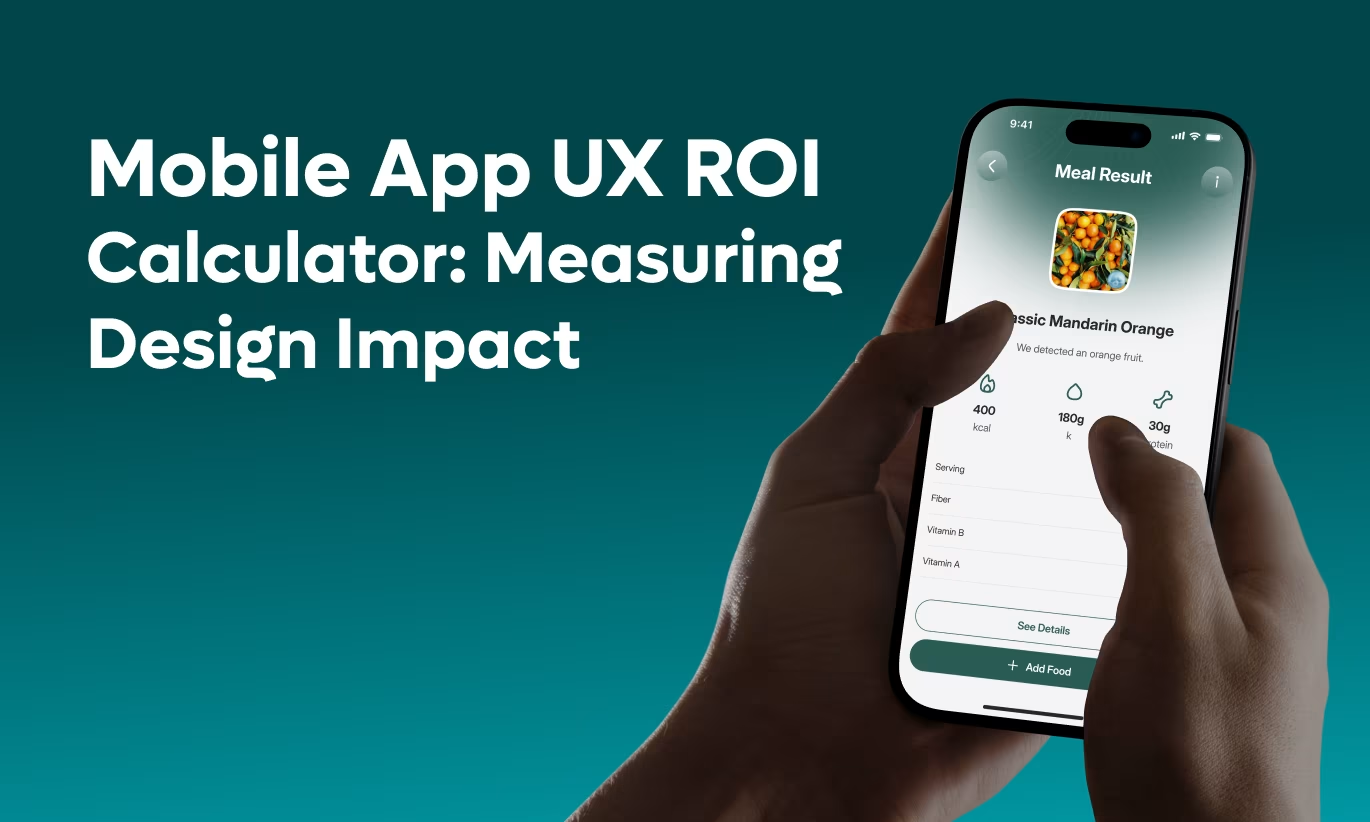Table of Contents
- The Problem: Why UX Investment Is Still Misunderstood
- Retention Improvement Benchmarks by App Category
- Financial Modeling: Translating Retention into Revenue
- When UX ROI Falls Short
- ROI Predictability: Category Confidence Levels
- The ROI Timeline: What to Expect
- How to Use This Framework for Your App
- Conclusion: Treat UX as an Investment, Not an Expense

When mobile app leaders pitch UX redesigns to finance teams, they’re often asked the same question:
“What’s the actual ROI?”
Most respond with broad claims — “UX improves engagement”, “Better design boosts retention.”
True, but vague. Those statements don’t unlock budget approvals.
The truth is, UX ROI is not unmeasurable — it’s just unmeasured.
Most teams lack a structured framework for quantifying how UX improvements translate into real financial results.
After analyzing 200+ mobile app redesigns across fintech, e-commerce, healthcare, SaaS, and gaming, we found that UX ROI is not only real—it’s predictable. The data shows clear retention and revenue correlations that can guide smarter investment decisions.
The Problem: Why UX Investment Is Still Misunderstood
1. Comparing Apples to Oranges
A fintech app may spend $200K and see a 6% retention lift.
An eCommerce app spends $150K and gains 14%.
Without a shared framework, these results look incomparable — and decision-makers lose clarity.
2. Unrealistic Timelines
UX redesigns take time. The true ROI window is 4–8 months, not 2–3.
Teams that evaluate too early often mistake “ramp-up” for “failure.”
3. Short-Term Thinking
UX isn’t a one-time win. Once retention improves, its compounding effect multiplies over time — improving month-over-month active users and long-term lifetime value.
Our Proprietary Framework: Measuring UX ROI Across 200+ Apps
To go beyond generic claims, we analyzed:
- Pre- and post-redesign retention rates
- UX investment costs
- 12- and 24-month revenue changes
- ARPU (Average Revenue per User) shifts
- Category-specific friction points
By isolating UX-driven improvements from other factors (marketing, pricing, etc.), we built a data-backed UX ROI Benchmark Framework that shows measurable retention gains per category.
Retention Improvement Benchmarks by App Category
🛍 E-Commerce Apps — 12–18% Retention Gain
UX directly fixes checkout friction — the most measurable pain point.
Top improvements included:
- One-tap checkout and simplified payment flows
- Product information clarity
- Smarter search and discovery UX
Case Example:
A shopping app lifted retention from 28% → 42% post-redesign, adding $2.1M annual revenue from a $280K investment (7.5× ROI).
📈 SaaS & Productivity Apps — 8–15% Gain
UX drives adoption through smoother onboarding and clearer workflows.
Key improvements:
- Shorter time-to-first-value
- In-app feature guidance
- Better progress feedback
Example:
A project management SaaS app improved retention from 31% → 42% (+11 pts), unlocking 44% ROI within 8 months.
💳 Fintech Apps — 6–10% Gain
Here, UX primarily reduces anxiety and confusion, not friction.
Key focus areas:
- Transaction clarity & confirmation feedback
- Error messaging & reassurance
- Simplified account management
Example:
A payments app saw retention climb from 24% → 31%, a 7-point gain from $420K UX spend, achieving 37% ROI in Year 1 and 274% in Year 2.
🕹 Gaming Apps — 5–12% Gain
ROI depended on addressing core engagement loops, not just aesthetics.
Successful redesigns clarified:
- Progress feedback
- Reward systems
- Monetization flow
🏥 Healthcare Apps — 10–14% Gain
UX clarity directly drives user trust and repeat behavior.
Effective changes included:
- Appointment flow simplification
- Prescription and record clarity
- Privacy reassurance
Example:
A telehealth app improved retention from 29% → 41%, adding 12 points and $900K+ in annual revenue.
💬 Social & Community Apps — 12–17% Gain
UX ROI here comes from frictionless connection and discovery.
Improvements focused on:
- Friend/follower discovery UX
- Feed relevance
- Notification optimization
Financial Modeling: Translating Retention into Revenue
The basic ROI equation is simple:
Annual Revenue = MAU × Retention × ARPU × 12
Example:
- 100,000 MAU
- 35% retention
- $2 ARPU
→ $840K annual revenue
If UX lifts retention to 41%:
→ $984K annual revenue, +$144K yearly.
Even a small retention boost compounds powerfully. Over 2 years, ROI often exceeds 200–300%, with payback inside 5–7 months.
Case Study Snapshots
E-Commerce App
- Retention: +14 pts (32% → 46%)
- Investment: $320K
- Year 1 ROI: 175%, payback in 4.4 months
SaaS App
- Retention: +10 pts (38% → 48%)
- Investment: $180K
- Year 1 ROI: 44%, Year 2 ROI: 150%+
Fintech App
- Retention: +8 pts (18% → 26%)
- Investment: $420K
- Year 1 ROI: 37%, Year 2 ROI: 274%
When UX ROI Falls Short
1. Solving the Wrong Problem
Investing in retention when acquisition is the bottleneck leads to poor ROI.
2. Weak Implementation
Designs are only as strong as their execution. Engineering errors can erode all gains.
3. Category Mismatch
Copying UX models from other verticals (e.g., e-commerce → social) fails because user intent differs.
4. Evaluating Too Early
True UX ROI takes 6–8 months to emerge. Midway evaluation = misleading data.
ROI Predictability: Category Confidence Levels
The ROI Timeline: What to Expect
How to Use This Framework for Your App
- Benchmark Your Category
Match your app type to expected retention improvement ranges. - Model Financial ROI
Use your actual MAU, ARPU, retention, and cost data to project returns. - Target Specific UX Problems
Don’t “redesign everything.” Fix the friction that directly affects retention. - Track Implementation Quality
Ensure design intent matches engineering output. - Evaluate at 6–8 Months, Not 3
Give redesigns full adoption time before measuring impact.
Beyond Retention: Secondary ROI Drivers
- Increased Monetization: Better UX improves premium conversion rates.
- Lower Support Costs: Clearer UX = fewer tickets = cost savings.
- Organic Growth Boost: Happy users refer others; retention compounds.
- Faster Time-to-Value: Improved onboarding shortens activation gaps.
Conclusion: Treat UX as an Investment, Not an Expense
The data is clear:
UX design drives measurable, predictable financial outcomes.
Across industries, UX ROI ranges from 37% to 275% in Year 1, often compounding into multi-year gains.
When done right—targeted, data-driven, and category-aware—UX isn’t just about aesthetics.
It’s a strategic growth lever with measurable impact on revenue, retention, and brand equity.
UX ROI isn’t hypothetical. It’s quantifiable. The only question is: will you measure it—or guess it?






